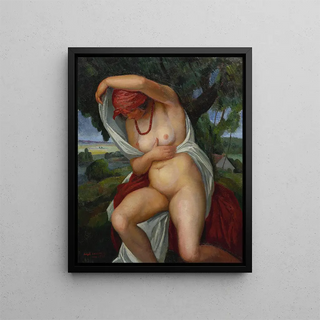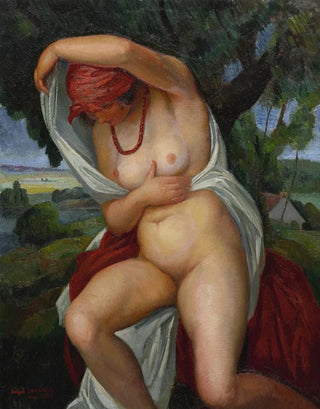Art print | Lieutenant - Ángel Zárraga


View from behind

Frame (optional)
In the vast panorama of art history, certain works stand out for their ability to capture the essence of an era and evoke deep emotions. "Lieutenant - Ángel Zárraga" is one of those creations that transcend the simple frame of painting to become a true window into the human soul. This piece, both powerful and delicate, invites the viewer to immerse themselves in a universe where light and shadow intertwine, revealing buried stories and feelings. The depiction of the lieutenant, an emblematic figure, stands proudly but with palpable melancholy, as if the artist aimed to immortalize a moment of vulnerability at the heart of bravery.
Style and uniqueness of the work
Ángel Zárraga's style is marked by a unique sensitivity, blending various influences while remaining deeply rooted in Mexican tradition. The color palette chosen for "Lieutenant" evokes an atmosphere that is both solemn and vibrant, where earth and sky tones meet in a captivating visual dialogue. The brushstrokes, both precise and expressive, demonstrate technical mastery that leaves a lasting impression. Every detail, whether it be the folds of the uniform or the expression on the face, is carefully crafted to convey psychological depth. This painting does not merely depict a character; it tells a story, that of a man caught between his duties and doubts, between bravery and fragility.
The artist and his influence
Ángel Zárraga, a key figure of the early 20th century, managed to leave his mark on his era through an innovative artistic approach and sharpened sensitivity. Originating from Mexico, he navigated between various influences, from Impressionism to modern art, while developing a personal style that is uniquely his own. His work often reflects a quest for identity, a dialogue between tradition and modernity. Zárraga captured the essence of his country while incorporating universal elements that resonate beyond borders. "Lieutenant" is a perfect illustration of this duality, where the strength of the military figure

Matte finish

View from behind

Frame (optional)
In the vast panorama of art history, certain works stand out for their ability to capture the essence of an era and evoke deep emotions. "Lieutenant - Ángel Zárraga" is one of those creations that transcend the simple frame of painting to become a true window into the human soul. This piece, both powerful and delicate, invites the viewer to immerse themselves in a universe where light and shadow intertwine, revealing buried stories and feelings. The depiction of the lieutenant, an emblematic figure, stands proudly but with palpable melancholy, as if the artist aimed to immortalize a moment of vulnerability at the heart of bravery.
Style and uniqueness of the work
Ángel Zárraga's style is marked by a unique sensitivity, blending various influences while remaining deeply rooted in Mexican tradition. The color palette chosen for "Lieutenant" evokes an atmosphere that is both solemn and vibrant, where earth and sky tones meet in a captivating visual dialogue. The brushstrokes, both precise and expressive, demonstrate technical mastery that leaves a lasting impression. Every detail, whether it be the folds of the uniform or the expression on the face, is carefully crafted to convey psychological depth. This painting does not merely depict a character; it tells a story, that of a man caught between his duties and doubts, between bravery and fragility.
The artist and his influence
Ángel Zárraga, a key figure of the early 20th century, managed to leave his mark on his era through an innovative artistic approach and sharpened sensitivity. Originating from Mexico, he navigated between various influences, from Impressionism to modern art, while developing a personal style that is uniquely his own. His work often reflects a quest for identity, a dialogue between tradition and modernity. Zárraga captured the essence of his country while incorporating universal elements that resonate beyond borders. "Lieutenant" is a perfect illustration of this duality, where the strength of the military figure






